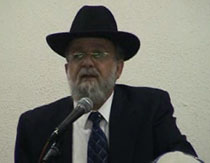Beit Midrash
- Sections
- Chemdat Yamim
- Parashat Hashavua
- Torah Portion and Tanach
- Bereshit
- Chayei Sara
Avraham opened the negotiations with the statement: "I am a foreigner and a resident among you; give me a burial plot with you and I shall bury my deceased from before me" (ibid. 4). The Ramban infers from Avraham’s language that if they would not give him the plot he requested, he would leave Sarah unburied, in a coffin. The Ramban’s claim is very difficult. Would Avraham have not heeded the halacha that if someone fails to bury the deceased he violates a Torah commandment (Sanhedrin 46b; Rambam, Avel 12:1), as the pasuk says: "You shall certainly bury him" (Devarim 21:23)?
We should look at the gemara’s discussion of the reason for burial. The gemara wonders if burial is needed to prevent the disgrace that people see the deceased’s decaying body or whether it is needed for atonement for the deceased [as the body is lowered (Rashi)]. The gemara says that the practical difference between the reasons is in a case where prior to death, the person asked not to be buried. If it is a matter of disgrace, he does not have the ability to waive the requirement, but if it is to obtain atonement, he can say that he does not want the atonement.
Now we can understand the Ramban’s claim. Sarah dedicated her whole life to advancing belief in Hashem. We know that Chazal explain the phrase "the lives that they made in Charan" (Bereishit 12:5) as "Avraham would convert the men, and Sarah would convert the women" (Bereishit Rabba, Lech Lecha 39). Sarah also dedicated her life to acts of chesed like tending to the stream of guests and helping people materially while causing the Name of Hashem to be beloved among those who came in contact with Avraham and Sarah (see Sifrei, Vaetchanan 32).
The Kli Chemda explains that it was after the sin of Adam and Chava that it was decreed that after death they would return to the earth from which they were taken. However, the necessity to do so was not nearly the same for someone who lived a life of perfect dedication to Hashem, free of sin at 100 like at 20 (see Rashi to Bereishit 23:1). Sarah did not need atonement like other people. As far as there not being a problem of people seeing the decay of the body, the problem could be solved by placing the remains in a coffin. Thus, Avraham’s opening position – if he would not receive the special plot he wanted, he would not bury Sarah – was not an empty threat. It was a real possibility. Of course, Avraham was not looking to save money with his negotiations, as he demanded to pay in full and then some. Rather, he wanted to ensure that the woman who had made all elements of her life a sanctification of Hashem’s Name would find her final resting place in the place where her legacy and the lessons of her life would have their ultimate impact.

Parashat Hashavua: Leadership of Yosef – For How Long?
Rabbi Yossef Carmel | Tevet 5786

Menora or Chanukiya?
Rabbi Yossef Carmel | 5774

Parashat Hashavua: More on Weddings and Mending Family Fractures
Rabbi Yossef Carmel | Tevet 5786





















